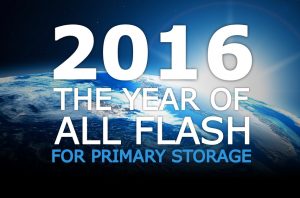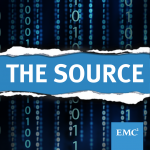It’s amazing to watch the evolution of Flash Storage. From early development in the 1980s to the arrival in enterprise storage systems in 2008, all along people have predicted the year of Flash! Well, I believe that we can say 2016 is the year of Flash!

Why? Here are 10 reasons 2016 is different than previous years… Flash is the new normal, no longer disruptive!
#1 – The Evolution of Flash Storage goes Vertical: NAND Flash manufacturers have reached the limits of traditional 2 dimensional manufacturing capabilities; you just can’t get any smaller on the physical silicon. What next? 3D NAND, build up! Density will continue to increase!.
#2 Economics of Scale: As NAND Manufacturers switch to 3D NAND, economies of scale will continue to drive adoption and evolution, reducing price.
#3 Flash is Everywhere: Smart Phones, Solid State Disk Drive (SSDs) and Consumer Tablets, in that order, are the biggest consumers of Flash on the planet.
#4 Not just for the Enterprise: Flash was first introduced into enterprise storage systems in 2008 by EMC. At that point, only the most demanding, revenue generating workloads could justify the added cost. Economies of scale have completely changed that equation. Flash is now the go to storage media for any size data center.
#5 Nand Manufacturers are Gearing Up: Back in 2013, NAND manufacturers started the process of changing facilities to support manufacturing of 3D NAND over traditional 2D. The last of those facilities are now coming on line and producing 3D Flash.
#6 Performance, Low Latency now a Given: Flash has changed the storage conversation forever; Disk Performance and Latency are no longer a competitive differentiator for anyone. They are table stakes, what your storage software and architecture provide matters most.
#7 Environmental Impacts: The obvious benefits: Less power, less cooling, more reliable (less replacement costs). The less obvious benefits: Data Reduction (Compression/Deduplication), Increased CPU Utilization, Less Data Copies (Single Source)
#8 Tiers of Flash now a Reality: While TLC represents the future of Flash Storage, tiers of Flash, much like tiers of spinning disk, provide the ability to create capacity tiers between SLC, MLC and 3D NAND.
#9 The 16TB Drive: The introduction of the 16TB 2.5” 3DNAND SSD represents The tipping point, the largest capacity drive in the world is now Flash! And it will soon be eclipsed by the 32TB 2.5” Drive – The Future is Now!
#10 Flash as Memory – The Future is Bright: Storage Class Memory.. .When memory and storage mix! RRAM (Resistive RAM), PC-RAM (Phase-change RAM) – This is gonna get good!!!
Still don’t believe me? Stay tuned to insideflash.emc.com as the flash evolution continues. And be Sure to check out EMC The Source Podcast, your Source for EMC Products Technologies and Solutions. Don’t miss “EMC The Source” app in the App Store. Be sure to subscribe to
The Source Podcast on iTunes or Stitcher Radio and visit the official blog at thesourceblog.emc.com





